How 'The Woman King' Costume Designer Creates New Worlds Through Clothing
- Oops!Something went wrong.Please try again later.
- Oops!Something went wrong.Please try again later.
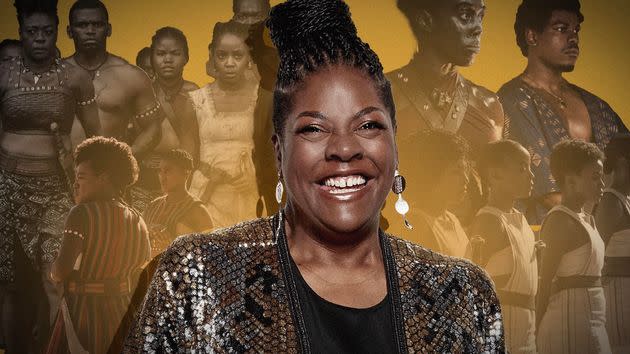
Gersha Phillips designed the costumes for the movie "The Woman King."
The glitz and glamour of entertainment is nothing without the people who dress today’s biggest stars. For “Who’s Behind the Clothes,” HuffPost spotlights stylists and costume designers who have delivered some of our favorite celebrities’ or characters’ most memorable looks. Read my interview with editorial stylist Alexander-Julian Gibbson.
Gersha Phillips’ 17-year journey in costume design reached new heights a few years ago, the moment she received a phone call from director Gina Prince-Bythewood. After rounds of interviews, she landed the role of lead costume designer on “The Woman King.” But before that moment, and before she outfitted characters on “Star Trek: Discovery,” Phillips was a teen from Saskatchewan, Canada, who wanted to become a fashion designer.
Born in London and now based in Toronto, Phillips grew up in a Trini-Nigerian household. While her mother was a nurse by day, she was also a master seamstress, fashioning a crochet jumpsuit for her daughter. In her free time, Phillips flipped through magazines, fawning over designs from Karl Lagerfeld, Jean Paul Gaultier, and John Galliano, and made clothes for her brother’s dance troupe. She never missed an episode of Canadian fashion editor and TV personality Jeanne Beker’s show.
“She would talk to the fashion designers and they would talk about their shows and where they were getting their inspiration for their shows from and what stories they were trying to tell,” Phillips said. “It’s the same idea of telling a story through clothing. These designers all were very creative and drew from so many different worlds and things it was just amazing to listen in, and sort of just get a little glimpse into that.”
A self-proclaimed “film buff,” Phillips initially sought to pursue design school in Toronto, but a film class about directing changed her trajectory. She attributes her “lightbulb moment” to the 1988 film “Beaches,” which materialized her passion for costume design and jump-started her career in 1995. Phillips, 60, has costume-designed for films and television series, such as “House of Cards,” “My Big Fat Greek Wedding 2,” “Star Trek: Discovery” and more. Now, she’s embarking on her next challenge: designing for “Captain America: New World Order.”
“For me personally,” she said, “I do like things where I get to world-build. ‘Discovery’ was a complete world-build; you’re building everything from scratch and trying to create whatever you think the future will be. For ‘The Woman King,’ it’s similar where I’m designing and creating a new world from the past.”
For “Who’s Behind the Clothes,” Phillips talked to HuffPost about costume-designing on “The Woman King,” the purpose clothes serve in world-building and storytelling, and more.
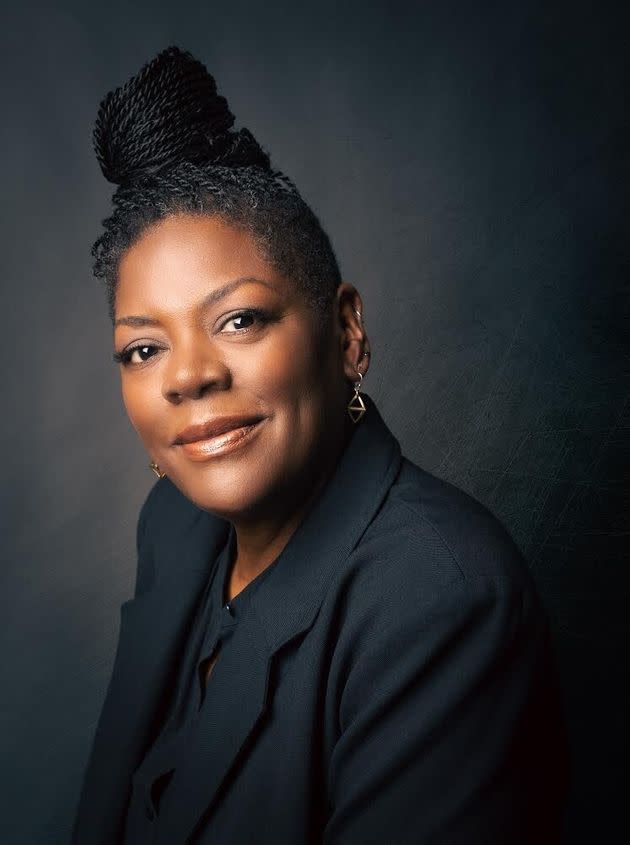
Raised by her Trinidadian mother and Nigerian father in Saskatchewan, Toronto-based costume designer Gersha Phillips is behind the clothes in "The Woman King."
Tell me about your journey to “The Woman King.” What drew you to the project, and what does it mean to you?
My agent called me and told me about it, and I was like, “What? This is happening?!” I was just beside myself. It was a no-brainer, obviously, when I was asked to interview, so I put together a presentation. I’ve always been over the top or tried to do more than is necessary for these types of things; so of course, in this case, I did even more than I would normally do. I already started doing a little bit of research, I had some illustrations done for it, and put it all together and got ready for this interview. I remember telling Gina [Prince-Bythewood] and [producer] Cathay [Schulman] how honored I was to be considered and to have the opportunity to interview. I felt that my whole career had been building up to this point. We had, I think in total, three meetings before they said that they wanted me to meet with the studio. Then I had a meeting with the studio where I didn’t realize I was going to be meeting with 10 people. I had a meeting with the execs and everybody. I guess that went well, because then I got a call from Gina saying that she was offering me the job after that. I still pinch myself that I was lucky enough to get that offer and that they chose me. I think that Teri Shropshire and Kasi Lemmons had a lot to do with that.
It was such an incredible experience. I’m proud of the work that we did on my team, the crew at large, and it was a momentous journey. For me, you know, it was an immense learning curve. It was not my first time working out of the country, but it was my first time working in Africa. I did a movie in Trinidad, which was much smaller and less building work, but just doing it in places where the industry is more in a development stage than it is in North America was definitely a challenge and a learning curve. Keeping your crew interested and motivated to keep going when they’re building the same thing over and over again, and they don’t understand why. I think for me I’m looking forward to taking on bigger and more interesting projects and I would love to do more work in this diaspora. While the research was tricky, I feel like if I had to do it again, I would look into different places and have better ideas of where to go.
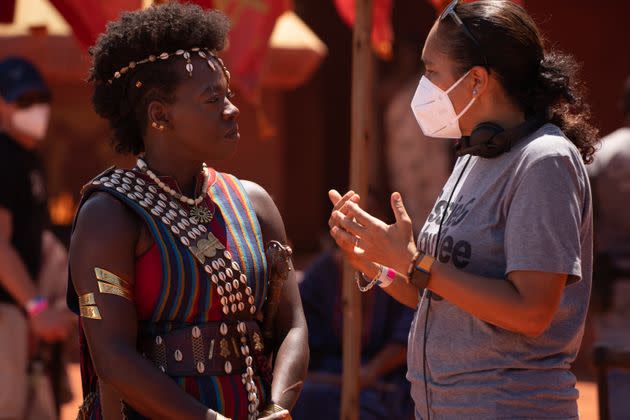
Viola Davis (left) as Nanisca and director Gina Prince-Bythewood on the set of "The Woman King."
What did the research process for this film entail, especially working on a piece that alludes to so much history? I noticed various details in the costuming, from incorporating cowrie shells and tribal markings to the differences in garment color between members of the Agojie and Oyo tribes.
I think for research, it never stops. You’re just always doing it when you do this type of film. The research for this was tricky, because most of it is told from a white male point of view. You have to sort of sift through that narrative to find what you want to find. It’s negative, and it’s derogatory, so it becomes hard. I remember slogging through it and not wanting to read anymore, because I was just like, “Oh, my God. I can’t take reading these essays by these men.” So that was a journey in itself.
The script described this cowrie shell breastplate. When I found the pictures of the cowrie shell breastplates and the pictures of the Agojie in that look, I was like, “Oh, this is it. And this is what I thought it was.” As I started to read, I never found that description of that particular uniform. I also started to look at it and go, “Well, if you were fighting, how would you fight in that? That would be very hard to fight in.” They described a little bit about the fighting and how they fought, etc., in some of these essays. I started to question it. I mentioned it to Gina and said, “Look, I can’t find anything about this in any of the writing I have. I have this look, this look, and this look. These are the other ideas I found, but I can’t find this particular thing.”
It wasn’t till we found this historian — and it took about a month before we could actually talk to him — and he was the one who said no, the cowrie shell look was a redress by Europeans for the World’s Trade Fair. That took a long time for us to decipher for sure that that was something we weren’t going to do. It was sort of picking things that we’ve seen that were real, like the banding of the breasts was real, so that can become part of the uniform. The cross straps that they wore looked like that’s what they used to hold weapons with, so that’s where the halter sort of comes from. The long trousers that they wore were obviously a little longer because they were men’s trousers, and they originated from the Hausa tribe.
I always wanted to have some indigo in the uniform. Indigo and block printing is very synonymous with West Africa, so I thought that was very important to incorporate into the look. It was a print that I had found in London at this woman’s store called the African fabric store in North London. But she had pulled it from Gambia; I got in touch with her, she got in touch with the person who made the fabric in Gambia, and he ended up making a skirt fabric for us. We’ve got great images of him doing the block print, some with the wax resist, then doing the indigo dye and everything. It’s made traditionally how it probably would have been made at the time.
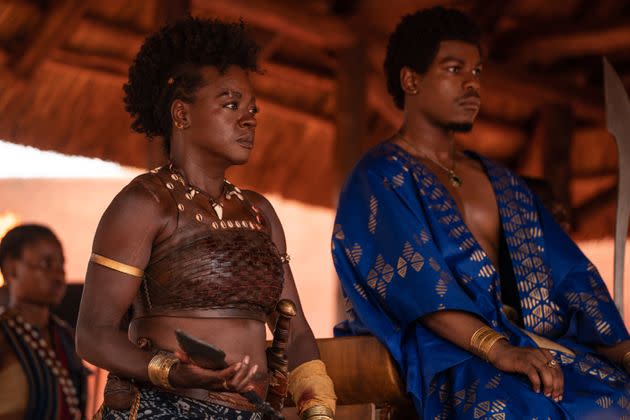
Davis (left) and John Boyega star in "The Woman King."
You noted that you had to parse through a white male perspective while in research. Do you recall the books you were reading?
“Amazons of Black Sparta” was one, and I had it in several different versions. That one had the illustration of the Agojie on it, so that was where the original silhouette of the palace tunic comes from. Two of the other books are books that are online only, and it’s one I got from the production designer. But the book that I think was my favorite book to read was this book called “Images Dahomey,” and it was a photography essay by a French photographer. He went to West Africa in 1906, I believe it is, and took all these amazing pictures. That’s what I use predominantly as my inspiration, especially for the village, doing the court and dressing when we did the palace scenes. There were just some amazing images of the women dressed, and even men, and how they would layer the fabrics. That’s sort of where [we got inspiration for] the drapes that Nanisca and Amenza wear over their uniforms, and how we elevated those palace tunics for those special days, such as the test day and the tribute day.
What do you think is the responsibility of a costume designer working on a project such as this to deconstruct those colonial tropes about how these tribes dressed — but also being cognizant of possibly aestheticizing the African continent?
The thing about West Africa, for me, is that it was one group of people at one point in time, and then they split off into these different groups. So, I do feel like there’s a lot of sharing and similarities between them. I feel as a costume designer, I’m dealing with a story and I’m telling a story. I’m not doing real life, I’m not doing a documentary. If I was, I would be doing a very different job. I did approach it like the documentary from the beginning, but was told not to. The story is what’s written on the page, but [we] also service a director’s vision, a producer’s vision, and so on, then collaborate with the actors when they come in and they bring their thoughts to the table. I have to take all of those things and make them into something that we can put on the screen.
You don’t always honor what you think is right as a costume designer; you end up straddling a lot of different people’s visions and ideas. We’re hired to serve an agenda and a vision of other people’s. Also, it’s what’s available to you at the time. I’m in South Africa, which actually does not have a lot of resources for this type of film. I thought it would, but Ghana ended up having the best things; we were going to be shooting in Ghana, so it was an easier segue for us to find something. We found somebody in Ghana, who helped us immensely with finding fabrics. She was the person who found the weavers that wove our tunics, etc. I feel that while it may not be historically accurate, it is a depiction of a fictionalized idea based on a true story.

"I always wanted to have some indigo in the uniform. Indigo and block printing is very synonymous with West Africa, so I thought that was very important to incorporate into the look," Phillips said.
Can you tell me about how the costumes convey the movie’s themes: maternity, sisterhood, war and resistance? During the blood ceremony, we see the Dahomey warriors adorned in white. Before they go into battle, they’re wearing the maroon halter tops. At the end, we see this beautiful display of womanhood, with Nanisca and Nawi wearing vibrant, bright colors.
We wanted each section of their lives to have a real sort of definitive idea behind it or story behind it. The battle gear is for battle; when they’re fighting in it, it looks real, and it works in terms of their freedom of movement. We also added different talismans; they carried their talismans in those little pouches. We also added different adornments and etchings to their belts. The actors were able to come in and pick different symbols that we use, which were based on the Dahomey, but we also did look at stuff from the West African area in general. People were able to pick different symbols for themselves in terms of being able to put that onto their costumes, so it personalized it a little for each actor.
The other things that were important are cowrie shells; not only are they a currency, but they also are used for protection. We tried to infuse that into a lot of their battle costumes and in their palace uniforms as well. The palace uniforms were worn as a sense of pride and in the city as well. We had the lower rank and then the higher rank that had the gold stripes in it just to show the elevation of it. In terms of adding embellishments to show different rankings of the Agojie, for instance, Nanisca has the red with the gold; then, because Amenza’s the religious leader, she has the white on hers.
Is there a particular look from the movie that stands out to or really resonated with you?
I do really love Viola’s tribute look, with the crossbelt of the cowrie shells, then the swag on it with the red and the gold and then the other layer underneath. It’s a tricky thing to put together when you’re mixing patterns like that, so balancing that was a little bit of an effort. I really liked the way that she looked in it in that scene. I think it made her look powerful, even though she was a little compromised when she saw Oba; she withers in it a little bit. But I do feel that it’s a really good depiction of her power. Also, I think her battle uniform is probably one of my favorites as well. I really think that one has a really strong feel for her as a warrior and as a general.

(Front row, from left) Lashana Lynch, Davis, Shelia Atim, (second row, from left) Sisipho Mbopa, Lone Motsomi and Chioma Umeala in "The Woman King."
Who instilled your love for clothing?
[My mom] had a love of clothes and so did my grandmother. I remember when I was younger, getting gifts from my grandmother. I would get these outfits and pieces of clothing, and they were beautifully made. My mom actually made me a crochet jumpsuit, which was one of those things that’s pretty phenomenal. I feel like even though my mom wasn’t a creative, if she had a chance to choose her own career, she would be. I do feel like I got a lot of my beginnings, a lot of my love for the craft and a love of beautiful things from her. She collected things; she had lace that I actually used to make Barbie beds and early Barbie clothes. She was always sewing, making things and so on, for us. When I was old enough, I started augmenting things. I wanted my stuff to look more like what was in the teen magazines, like Seventeen, at that time.
[My teen years] were really tricky — being able to find anything that I really liked and have it fit my body the way I wanted it — because I was already quite curvy. In my teens, I was always making things for myself, then people got interested in it. I started making break-dance costumes for my brother’s friends and my boyfriend’s friends; they had a troupe. From there, I made baggy pants for them — sort of that hip-hop, urban look that everybody wanted — that you couldn’t get up there either. That’s how I got known.
Besides my mom, I feel like I was also heavily influenced by fashion designers. I remember coming to Toronto and going to The Bay, which was one of our main stores, and seeing Karl Lagerfeld clothing in person. I think that we had Thierry Mugler there and things like that. It was just really amazing to see those pieces of clothing, the construction of them and everything. To this day, one of the things I love doing is going to any major city and seeing whatever I can get a chance to have a look at.
What was the film that ignited the spark for you?
When I think about it, it didn’t have anything to do with costume design, because it was “Beaches,” the 1988 film. Sometimes, they put the designer at the end credit, but in this particular film, it’s at the beginning. I don’t even remember the name of the costume designer, to be honest, but I just remember seeing that and just going like, “Oh, that’s what I want to do.” For some reason, I understood at that moment what it was. Whereas before that, I feel like I didn’t really know what costume-design was or understand what it would be in relation to film, even though when I was in school, I had an elective and did theater and worked in the costume department in theater on a production. I don’t remember ever thinking, “Oh, this is what I want to do,” or how it relates to film or anything. I also was quite a film buff at the time, too. It was really interesting that I hadn’t put it together. I just say it’s like that lightbulb moment, like what Oprah talks about.
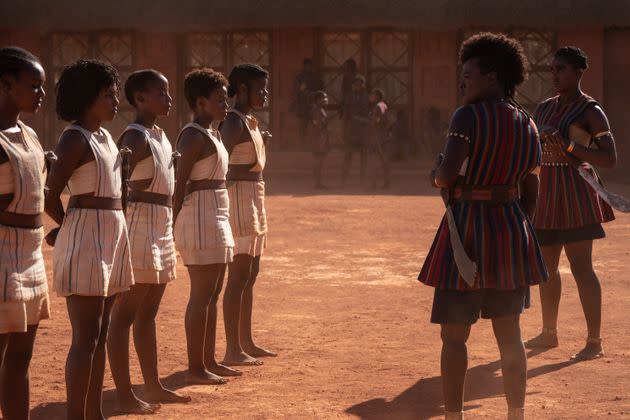
Through costume, Phillips sought to portray definitive sections of characters' lives in "The Woman King."
Now, you just started working on “Captain America: New World Order,” and previously, designed for “Star Trek: Discovery.” What was the pivot like working on “The Woman King”?
For me as a costume designer, it’s whatever pops up for me. It was a huge pivot for me from “Discovery” because we were doing futuristic, the 31st century, then going back in time to 1823. For me personally, I do like things where I get to world-build. “Discovery” was a complete world-build; you’re building everything from scratch and trying to create whatever you think the future will be. For “The Woman King,” it’s similar where I’m designing and creating a new world from the past. That really excites me. I feel like the biggest thing I like is going on the journey. Now with Marvel, I just printed out a list of the chronological order that the films go in and understand everything, because there’s little things in the script that talk about something that happened in another storyline. As for the characters that you’re working with, some of them have already been established, so you want to know how they’d been established and what they look like, so it’s not jarring to the fans. Ultimately, it’s always about telling stories, which is the best part of what we get to do. I like the change-up; it keeps your brain interested and invigorated.
You brought up the term “world-building.” How do you think costume design serves as a vehicle in “world-building”? How would you define it, and what does that mean to you?
Such a big question. To me, world-building and costume design, it’s like telling the story through clothing. It gives you this opportunity to show people different things. I don’t think everybody really registers what they’re looking at when they’re looking at a film or a picture, but it conveys something that they understand. They’re able to understand it by what they’re looking at. To me, ideally, I always thought of my clothing as something that was the backstory. The clothing really helps to put you in where you are and tells you what’s going on. You asked about that before in terms of what each clothing means to each scene and how it works. All these things add to that. And I think that’s what storytelling through costumes is about. It’s like giving information and setting a scene and telling a story in terms of a clothing perspective.
Related...
How Lucky Daye's Stylist Problem-Solves For Today's Biggest Emerging Stars
How Costumes In 'Black Panther: Wakanda Forever' Will Honor Chadwick Boseman
How Tiffany Hasbourne Elevated Southern Style On Donald Glover's 'Atlanta'
‘Insecure’ Costume Designer Nails Why Authentic Style Is Integral To Black Stories
